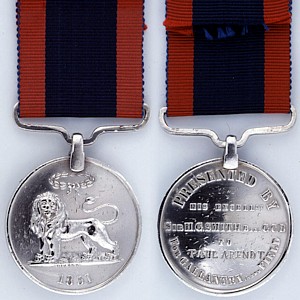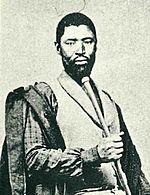Sir Harry Smith's Medal for Gallantry facts for kids
Quick facts for kids Sir Harry Smith's Medal for Gallantry |
|
|---|---|
 |
|
| Country | |
| Type | Military decoration for bravery |
| Eligibility | All ranks |
| Awarded for | Gallantry in action |
| Campaign(s) | 8th Cape Frontier War |
| Status | Unofficial |
| Statistics | |
| Established | 1851 |
Ribbon bar |
|
The Sir Harry Smith's Medal for Gallantry is a special award given for bravery. It was created a long time ago, in 1851, in what is now South Africa. This medal was not an official government award at first. It was given to soldiers who showed great courage during the 8th Cape Frontier War.
The medal was started by Major General Sir Harry Smith. He was the Governor and Commander-in-Chief of the Cape of Good Hope at the time. He wanted to recognise the brave actions of his soldiers, especially after a difficult time at Fort Cox in December 1850.
Contents
The 8th Cape Frontier War: A Tough Conflict
The 8th Cape Frontier War was a long and difficult conflict. It took place in the Eastern Cape region of South Africa. This war, which started in 1850, was one of the longest and most costly of the frontier wars.
Sir Harry Smith and the Xhosa Chiefs
Before the war began, Governor Sir Harry Smith went to Fort Cox. He planned to meet with important Xhosa chiefs there. However, Sir Harry Smith had a reputation for treating the chiefs poorly. This had made many Xhosa people angry. Even so, he believed they saw him as their "Inkhosi Inkhulu," or Supreme Chief.
One of the chiefs, Sandile kaNgqika, who was King of the Rharhabe clan, refused to attend the meeting. Because of this, Sir Harry Smith declared Sandile a rebel. He ordered other Xhosa groups to capture Sandile. This demand was the final straw for many. Soon after, Xhosa warriors, led by Chief Sandile, surrounded Fort Cox.
The Siege of Fort Cox
Fort Cox was not ready for a long siege. It did not have enough supplies or any cannons. Getting water was also very dangerous, as it meant going down to the Keiskamma River. Several attempts to send help to the fort failed.
Sir Harry Smith was worried that being trapped would lower the spirits of the colony. He also feared that loyal Xhosa tribes might switch sides. So, on December 31, 1850, he decided to fight his way out. He was escorted by about 250 men from the Cape Mounted Riflemen. These soldiers were mostly Khoisan and Coloured men led by white officers. Sir Harry Smith successfully broke through the Xhosa lines and reached King William's Town safely. Fort Cox was finally relieved on January 31, 1851.
Creating the Medal: A Special Award
Sir Harry Smith was very impressed by the bravery of the Cape Mounted Riflemen during the escape from Fort Cox. To show his appreciation, he created Sir Harry Smith's Medal for Gallantry. He wanted to recognise their excellent conduct.
Years later, Sir Harry Smith said that the "Hottentots" (a term used at the time for the Khoikhoi people) from the Cape were naturally very good soldiers. He believed they had a remarkable talent for military service.
Official Recognition for an Unofficial Medal
At first, the British government did not approve of Sir Harry creating his own medal. However, they later paid for the medals to be made. This act gave the medal some recognition, even though it was still not officially part of the British military awards system.
Some people consider Sir Harry Smith's Medal for Gallantry to be the first South African military medal. It was created before other famous British bravery awards. For example, it came before the Distinguished Conduct Medal (1854) and the very famous Victoria Cross (1856).
What the Medal Looks Like
The medal is a round silver disk, about 34 millimetres wide. It has a plain curved bar at the top, which connects to the ribbon.
Front of the Medal
The front of the medal shows a lion standing beneath a crown made of laurel leaves. The year "1851" is written at the bottom.
Back of the Medal
The back of the medal is plain. It has words written around the edges and in the middle. It says "PRESENTED BY" at the top, and "HIS EXCELLENCY," "SIR H.G. SMITH BART C.G.B." in the centre. There is an empty space where the recipient's name could be engraved. At the bottom, it says "FOR GALLANTRY IN THE FIELD."
The Ribbon
The ribbon for the medal is 32 millimetres wide. It has two brownish-red stripes, each 7 millimetres wide. These stripes are separated by a wider, 18-millimetre dark blue stripe in the middle.
Who Received the Medal
About 31 of these medals were given to officers and men of the Cape Mounted Riflemen. They received them for their brave actions during the war. We know the names of 23 recipients, and 20 of these medals were engraved with the soldier's name.
Some of the known recipients include:
- Paul Arendt
- Piet Jan Cornelis
- RSM William Richard Dakins
- Thomas Dicks
- Thomas Duncan
- Sapper R. Dunning, RE
- Henry Evans
- David Faroe
- Hendrick Ferara
- Fundi
- J. Hassall
- John Keiburg
- Lt. Edward Lister-Green
- John Main
- H. McKain
- John McVarrie
- Francis Meades, CMR
- J. Mouatt, CMR
- Capt. Skead, RN
- Adrian Strauss
Some medals were issued without names engraved on them. These include:
- Sgt. Lodewyck Kleinhans
- Sgt. Appolis Lieuw
- Sgt. Maj. Johannes Tass
The Medal's Importance Today
Even though Sir Harry Smith's Medal for Gallantry was not officially recognised by the government at the time, it is still very important in South African military history. It is one of four significant unofficial military awards from that period.
The other important unofficial medals are:
- The Johannesburg Vrijwilliger Corps Medal of 1899.
- The Kimberley Star of 1900.
- The Cape Copper Company Medal for the Defence of O'okiep of 1902.
These medals show the bravery of soldiers in South Africa's past, even if they weren't part of the official award system.
See also
- Harrismith
- Ladismith
- Ladysmith


